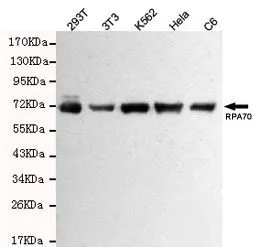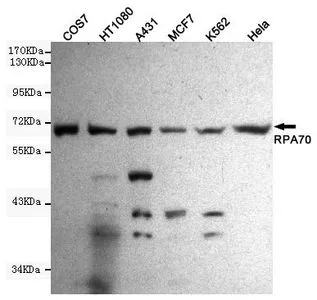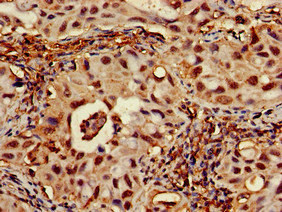
WB analysis of indicated lysates using RPA70 antibody at a dilution of 1:1,000.
RPA70 antibody [8C3-D12-H10]
GTX49157
ApplicationsWestern Blot
Product group Antibodies
ReactivityHuman, Monkey, Mouse, Rat
TargetRPA1
Overview
- SupplierGeneTex
- Product NameRPA70 antibody [8C3-D12-H10]
- Delivery Days Customer9
- ApplicationsWestern Blot
- CertificationResearch Use Only
- ClonalityMonoclonal
- Clone ID8C3-D12-H10
- ConjugateUnconjugated
- Gene ID6117
- Target nameRPA1
- Target descriptionreplication protein A1
- Target synonymsHSSB, MST075, PFBMFT6, REPA1, RF-A, RP-A, RPA70, replication protein A 70 kDa DNA-binding subunit, MSTP075, RF-A protein 1, RP-A p70, replication factor A protein 1, replication protein A1, 70kDa, single-stranded DNA-binding protein
- HostMouse
- IsotypeIgG2a
- Protein IDP27694
- Protein NameReplication protein A 70 kDa DNA-binding subunit
- Scientific DescriptionThis gene encodes the largest subunit of the heterotrimeric Replication Protein A (RPA) complex, which binds to single-stranded DNA (ssDNA), forming a nucleoprotein complex that plays an important role in DNA metabolism, being involved in DNA replication, repair, recombination, telomere maintenance, and co-ordinating the cellular response to DNA damage through activation of the ataxia telangiectasia and Rad3-related protein (ATR) kinase. The nucleoprotein complex protects the single-stranded DNA from nucleases, prevents formation of secondary structures that would interfere with repair, and co-ordinates the recruitment and departure of different genome maintenance factors. This subunit contains four oligonucleotide/oligosaccharide-binding (OB) domains, though the majority of ssDNA binding occurs in two of these domains. The heterotrimeric complex has two different modes of ssDNA binding, a low-affinity and high-affinity mode, determined by which ssDNA binding domains are utilized. The different binding modes differ in the length of DNA bound and in the proteins with which it interacts, thereby playing a role in regulating different genomic maintenance pathways. [provided by RefSeq, Sep 2017]
- ReactivityHuman, Monkey, Mouse, Rat
- Storage Instruction-20°C or -80°C,2°C to 8°C
- UNSPSC12352203



![ELISA analysis of antigen using GTX60579 RPA70 antibody [4C4]. Black : Control antigen 100ng Purple : Antigen 10ng Blue : Antigen 50ng Red : Antigen 100ng](https://www.genetex.com/upload/website/prouct_img/normal/GTX60579/GTX60579_20170912_ELISA_w_23061123_663.webp)


